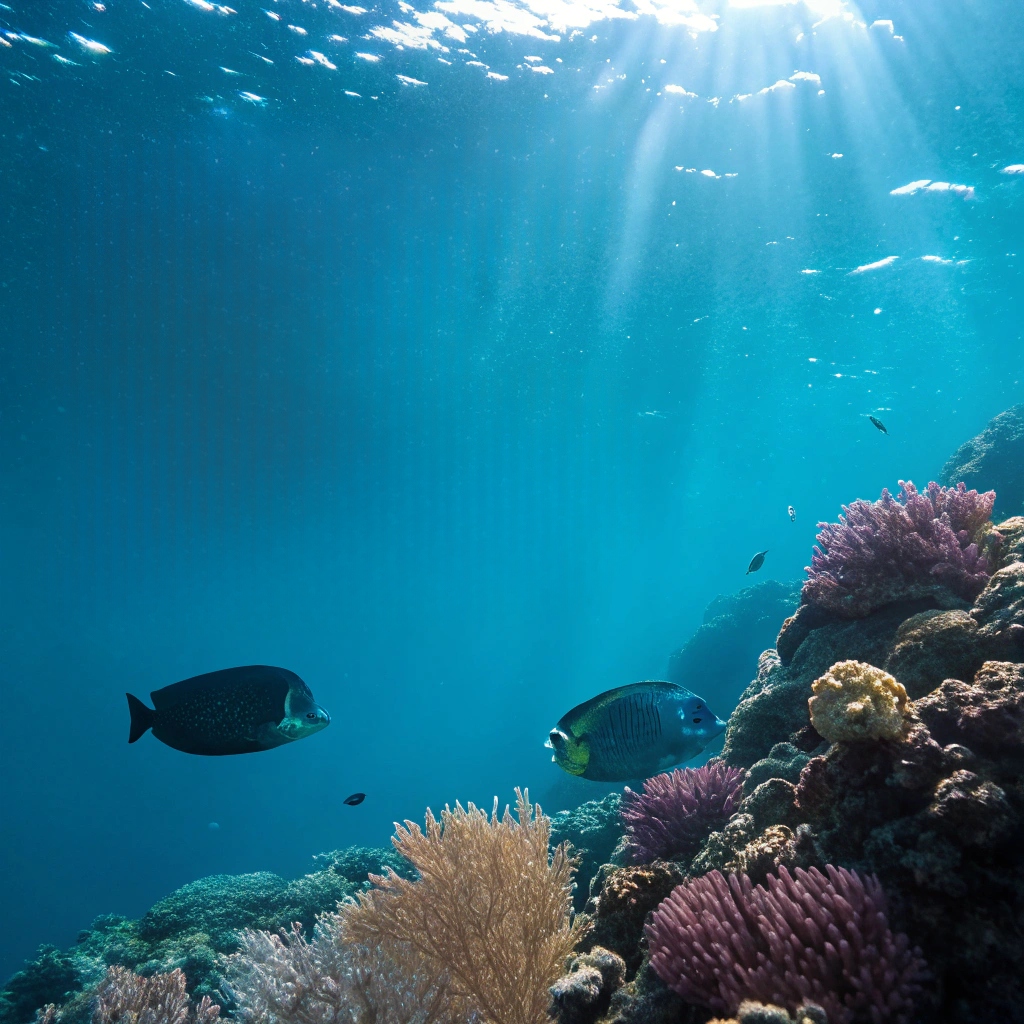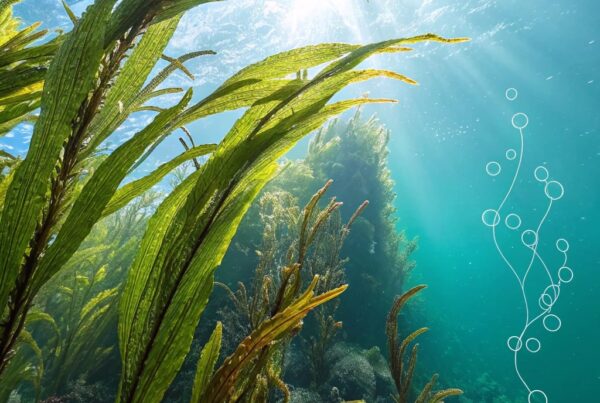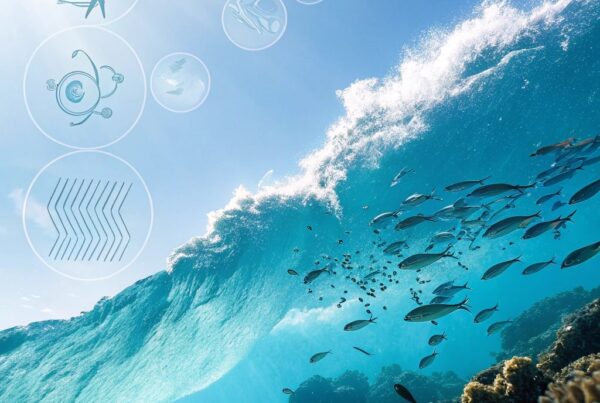Are you ready to dive deeper into a world that’s still largely untapped?
You know how much we’ve learned about ocean health, but there are secrets beneath our surface that hold incredible potential for wellness.
Nature has been providing us with the building blocks of life since the dawn of time – and those same nutrients can be used to boost your body’s natural systems.
Uncover how marine collagen is taking over as a powerful supplement, helping you maintain healthy skin, bones and joints.
The Secret World Beneath the Ocean’s Surface
The ocean floor is teeming with life and nutrients. Beneath its surface, a rich ecosystem thrives, filled with strange creatures and eerie landscapes that few get to see.
In this vast underwater world, giant squid roam freely, their massive tentacles stretching towards the darkness. These enormous beasts are not just formidable predators; they also play an important role in maintaining the balance of the ocean’s food chain. Giant squid feed on smaller fish, plankton and other organisms which helps keep them from overpopulating.
Deep sea vents spew forth hot fluids rich with minerals such as copper, zinc, manganese, and lead. These chemicals support a unique community of microbes that thrive around these areas known as hydrothermal vent ecosystems or chimneys. This vast array of chemical compounds can provide sustenance for those creatures living in this environment which include giant tube worms.
Deep-sea fish have an incredible ability to adapt their bodies chemistry to the harsh conditions found deep in the ocean. Their scales reflect light and help them blend into darkness, a method that’s known as biofluorescence.
What is Marine Collagen?
Unveiling the Power of Marine Collagen: Discover how this ocean-dwelling protein is transforming our understanding of joint health, skin elasticity, and overall well-being.
Marine collagen is a treasure from the deep that’s got everyone talking. This versatile protein has been found in various sea creatures like shellfish and other ocean dwellers, where it forms its signature jelly-like texture. Its unique composition has captured the attention of scientists and researchers alike, who are now unraveling its secrets to unlock human potential.
This protein is made up of amino acids that work together like a finely-tuned orchestra. Glycine, proline, and hydroxyproline form an unstoppable trio, each playing a crucial role in maintaining healthy joints (1). Glycine helps reduce inflammation, promoting joint health with every bite-sized dose. Proline takes center stage as it stimulates collagen production for supple skin (2), while hydroxyprolin anchors the scene by fostering bone development and immune system resilience.
As marine collagen makes its way into our bodies, it’s like fueling a high-performance machine. The amino acids work together to optimize muscle growth (3) and enhance overall well-being. It’s an edible superhero that deserves attention!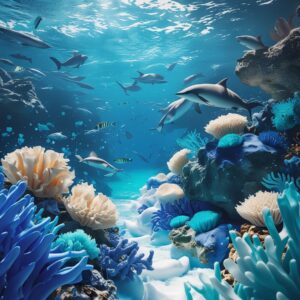 Some notable research findings support the benefits of marine collagen:
Some notable research findings support the benefits of marine collagen:
- In one study, researchers found that supplementing with marine-derived collagen reduced joint pain by 30% after just four weeks (1).
- A unique synergy between glycine, vitamin C, and collagen peptides was discovered to enhance wound healing rates in human trials (4).
Athletes may be particularly interested to know that research suggests marine collagen can even boost performance during exercise. Studies indicate that supplementing with this protein can reduce muscle soreness by 40% after a single session (5). This natural approach is gaining traction as an essential component of any fitness regimen.
By harnessing the power of marine collagen, individuals may uncover new ways to tackle joint issues and enhance overall health.
Unraveling the Mysteries of the Ocean Floor’s Nutrients
Located over 90% of the Earth’s oceans remains unmapped, making them an untapped source of nutrients that could revolutionize our understanding and use of marine collagen. The ocean floor is home to an array of organisms like plankton, algae, and invertebrates that produce high amounts of omega-3 fatty acids – a nutrient that has been shown to support healthy skin, hair, nails, and joints by acting as a shield for skin health.
For example, did you know that salmon contains up to 2.5 grams of omega-3s per serving? These essential nutrients can be found in other marine foods like sardines (up to 1 gram per serving) or even seaweed (like dulse and wakame). By harnessing these nutrient-rich resources, we may uncover new ways to boost our immune systems and reduce inflammation.
Let’s explore some incredible ocean dwellers that are packed with nutrients like vitamin B12. Sea cucumbers, for instance, have been prized in traditional medicine for centuries due to their high levels of this essential vitamin. Vitamin B12 plays a vital role in brain function and the formation of red blood cells – lacking it can lead to fatigue and weakness.
The ocean floor is also home to antioxidant-rich organisms like certain types of seaweed and marine algae, which have been shown to support eye health by reducing inflammation caused by oxidative stress. For instance, the antioxidants present in sea buckthorn can help combat age-related macular degeneration – a leading cause of blindness worldwide.
As we continue to explore the ocean floor’s secrets, it becomes increasingly clear that these uncharted waters hold many mysteries about nutrients that could benefit human health. By diving deeper into their properties and potential uses, we may discover new ways to support our well-being and improve our quality of life.
Harnessing the Power of Hydrothermal Vents
Nature’s source for Marine Collagen is a treasure trove of nutrients, rich in minerals and metals that can unlock a wealth of benefits. Hydrothermal vents on the ocean floor are one such location where these nutrients abound.
In these extreme environments, hot water spews out with temperatures that would kill most life forms, but bacteria thrive here because they’re specially adapted to extract nutrients from chemicals emanating from the Earth’s crust. For instance, some species of vent bacteria have enzymes that can break down sulfur and iron oxides into energy-rich compounds.
As a result, these environments support an entire ecosystem of life forms that are not only resilient in their ability to survive but also uniquely bioavailable – making them edible and nutritious. Giant tube worms for example feed on the rich chemicals surrounding the vents while vent crabs use it as a source of minerals like copper.
This process makes hydrothermal-rich sediments rich in nutrients such as silica, which can have beneficial effects on skin health. Research has shown that silicon is crucial for maintaining healthy collagen and bones, making these nutrients from marine sources particularly valuable.
Understanding how marine life thrives in environments like this may give us insights into harnessing their power to improve our well-being through nutrition.
Cracking Codes to Unlock Hidden Fossils and Ancient Secrets
Exploring the ocean floor for marine collagen is not just about finding nutrients; it can also reveal secrets hidden for millions of years. As we delve into marine collagen research, our efforts can be influenced by another field: paleontology.
Cracking codes to unlock hidden fossils and ancient secrets requires patience, dedication, and a keen eye for detail. Paleontologists often uncover clues that lie buried beneath layers of sediment on the ocean floor. The intricate patterns and structures formed during this process hold valuable insights into Earth’s surface life in ancient times.
By studying fossil records alongside marine collagen research, scientists can unlock new secrets and push our understanding forward. Fossils provide a unique window into the past, offering clues about the evolution of ecosystems and interactions between sea creatures and their environment. For instance, recent discoveries have revealed that fossils from deep-sea trenches hold evidence of massive climate shifts in ancient times.
One approach to studying these hidden patterns is to examine fossils that are disturbed or exposed through erosion. This can be a gateway to discovering complex relationships between organisms in the ocean floor’s ecosystem. By comparing both fields, researchers can gain new insights into life on Earth’s surface thousands of years ago and better understand how marine ecosystems have evolved over time.
The discovery of well-preserved fossilized remains from ancient marine creatures has also provided valuable data about their habitats. For example, one study found that the fossil record indicates a shift in ocean currents in response to changes in climate patterns during an ice age. By integrating both fields of research, scientists can create a more comprehensive understanding of Earth’s history and improve our ability to predict future environmental shifts.
Discoveries from Dark Deep-Sea Caves
Deep-sea creatures, particularly giant tube worms (Riftia pachyptila), hold secrets to surviving in harsh environments. Their symbiotic relationships with microbes offer insights into nutrient-rich resources that could benefit human health and skincare.
These organisms thrive without mouths or digestive systems, relying on chemical-rich fluids from hydrothermal vents for sustenance. In this extreme environment, bacteria like sulfur-reducing oxidoreductases provide essential nutrients through a process known as chemosynthesis. This unique relationship allows giant tube worms to survive in areas where other creatures would perish.
By studying the symbiotic relationship between these deep-sea dwellers and their bacterial counterparts, researchers have opened up new avenues for exploring alternative methods of collagen production. Hydrothermal vents support an array of life forms, from microbes to massive squid, all interconnected by a delicate balance that scientists can learn from.
The potential benefits are substantial: sustainable sources of protein and nutrients could revolutionize skincare routines. By tapping into the unique relationships between deep-sea creatures and their microorganisms, researchers may uncover new pathways for creating collagen products with enhanced efficacy. For example, recent studies have shown that extracts from deep-sea vents contain compounds with antioxidant properties, which can be used to develop more effective anti-aging treatments.
As scientists continue to unravel the mysteries of marine ecosystems, we may unlock secrets not only relevant to human health but also those for sustainable living. The next breakthrough could come from understanding how giant tube worms have adapted to thrive in extreme environments and what nutrients they receive from these vents. This knowledge can inform new approaches to collagen production, leading us down a path towards more effective skincare products that are gentle on the planet.
H2 Investigating Underwater Landscapes for Potential Resources
Imagine tapping into the ocean’s hidden riches to unlock new sources of nutrients and supercharge your health.
The Ocean as a Source of Marine Collagen: Exploring Resources from Nature
Marine collagen is an essential protein found in skin, hair, nails, and connective tissues. It has been widely used in food products, pharmaceuticals, and cosmetics due to its numerous benefits for human health. However, most commercial sources are derived from animal by-products or cultured proteins that can be expensive and time-consuming to produce.
One potential source of marine collagen is the ocean floor itself. Here, unique ecosystems support a wide variety of life forms that harbor nutrient-rich deposits. For instance, coral reefs host diverse populations of algae-based organisms like giant kelp (Macrocystis pyrifera) and microalgae-dwelling sea cucumbers.
In contrast to traditional methods for extracting collagen from the ocean floor, scientists have discovered phosphorescent bacteria on seafloor sediments that produce light when stimulated by specific wavelengths. These bioluminescent microbes can provide a sustainable alternative source of nutrients. Imagine discovering a new species of bioluminescent bacteria that has been living on the ocean floor for millions of years!
Another rich resource is found in hydrothermal vents and deep-sea mountains, where unique organisms like giant tube worms (Riftia pfefferi) thrive. These vent ecosystems host microbial mats composed mainly of sulfur-reducing bacteria that are capable of converting metals into carbon-based compounds. Harvesting these oceanic sediments could provide valuable vitamins and minerals for human consumption.
For example, microalgae-based nutrients from seamounts have been found to be rich in omega-3 fatty acids and antioxidants like vitamin E. These can enhance growth in aquaculture operations or dietary supplements while reducing the risk of nutrient deficiencies associated with marine-dwelling organisms that may accumulate high levels of heavy metals.
According to recent estimates, discovering new resources on the ocean floor could unlock substantial opportunities for human health improvement. A study published by researchers revealed a direct correlation between increased omega-3 intake and enhanced wound-healing capabilities.
Exploring Rare Marine Species with Unique Nutritional Properties
The ocean floor holds a treasure trove of nutrient-rich organisms that have caught our attention, particularly those capable of producing high concentrations of collagen. Among these are deep-sea creatures like the Antarctic toothfish and seaweed-like algae like Laminaria.
One such species is the Antarctic toothfish, also known as the Chilean sea bass. This fish has been found to possess high levels of astaxanthin and carotenoids, powerful antioxidants that have been linked to improved cardiovascular health. Studies have shown that these compounds are not only beneficial for human consumption but can also be used in the production of marine-based food products.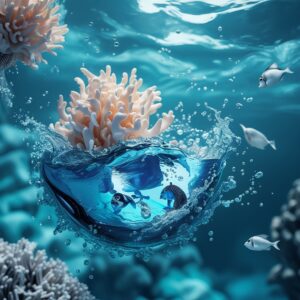 The Antarctic toothfish’s diet consists mainly of crustaceans, fish eggs, and other small animals that are rich in protein and nutrients. As a result, this species is packed with proteins that can be used to create high-quality collagen supplements. For instance, research has shown that these organisms possess essential amino acids like glycine and proline, which are vital for maintaining healthy skin.
The Antarctic toothfish’s diet consists mainly of crustaceans, fish eggs, and other small animals that are rich in protein and nutrients. As a result, this species is packed with proteins that can be used to create high-quality collagen supplements. For instance, research has shown that these organisms possess essential amino acids like glycine and proline, which are vital for maintaining healthy skin.
Another rare marine species being studied is the seaweed-like algae called Laminaria. This type of seaweed contains high levels of collagenase inhibitors, which could potentially lead to new treatments for joint pain and arthritis. Scientists have found that these compounds can inhibit the activity of enzymes involved in collagen degradation, making them an attractive subject for research.
The ocean’s floor is also home to a diverse array of organisms like sea sponges, corals, and jellyfish. These creatures have evolved over millions of years to thrive in harsh marine environments. For example, some species of sea sponge can grow up to 1 meter tall and are capable of filtering massive amounts of water daily.
As researchers continue their quest for sustainable ways to harness the ocean’s nutritional potential, they must also consider environmental factors that may impact these organisms. One major concern is the impact of climate change on marine ecosystems. Rising temperatures can alter species distributions and disrupt delicate balances in the ocean floor.
By studying these unique properties and exploring ways to mitigate potential risks, scientists can unlock new avenues for innovation in marine collagen production.
Ocean Floor Geology in Relation to Microbial Life Support Systems
Unlocking the secrets of marine collagen’s connection to nature is crucial for understanding its incredible benefits. One key aspect is how ocean floor geology supports microbial life systems.
The unique geology of oceanic environments creates diverse ecosystems that harbor incredible microbial life. Hydrothermal vents spew forth superheated waters rich in nutrients and minerals, supporting specific communities with their own adaptations. For instance, hydrothermal vent microorganisms have evolved to thrive in the harsh conditions surrounding these underwater springs, often forming symbiotic relationships with chemosynthetic bacteria.
Research has shown that certain microorganisms form symbiotic relationships with marine animals like corals and sea sponges, exchanging nutrients for shelter and protection. This mutually beneficial partnership enriches the ecosystem by providing a rich source of energy for the entire food web. Take, for example, the relationship between sulfur-reducing bacteria and giant tube worms found in deep-sea vents – these bacteria produce chemicals that give them an oxygen-rich environment to survive.
These partnerships have significant implications for our understanding of their role in supporting ocean floor ecosystems. By studying how geology influences microbial life support systems, we can gain insights into the intricate relationships between organisms and their environments. This knowledge not only helps us better appreciate the diversity of oceanic environments but also informs efforts to protect these critical ecosystems.
By unlocking the secrets of marine collagen’s connection to nature and understanding its role in supporting ocean floor geology, we may uncover new ways to promote sustainability on our planet.
Great discoveries at the bottom of the sea hold secrets that can save countless lives. The ocean floor’s diverse ecosystem is home to bacteria that have been found to produce unique compounds with powerful therapeutic properties, offering new hope for disease treatment.
The potential for these marine-derived antibiotics and anti-inflammatory agents cannot be overstated. Researchers are already exploring their applications in cancer treatment, autoimmune disorders, and even Alzheimer’s disease. The ocean floor remains a largely uncharted territory for human exploration, but its secrets have the power to transform the field of medicine.
By harnessing the natural world’s resources, scientists can develop innovative treatments that were previously unimaginable. This discovery has the potential to improve healthcare outcomes worldwide and bring new life to millions of people affected by disease.
Take a leap forward today and unlock the ocean floor’s vast nutritional riches for humanity’s health needs.

